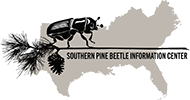Abstract
Forest insect pest disturbance is increasing in certain areas of North America as many insect species, such as the southern pine beetle, expand their range due to a warming climate. Because insect pests are beginning to
occupy forests that are managed for multiple uses and have not been managed for pests before, it is becoming increasingly important to determine how forests should be managed for pests when non-timber ecosystem services are considered in addition to traditional costs and revenues. One example of a service that is increasingly considered in forest management and that may affect forest pest management is carbon sequestration. This manuscript seeks to understand whether the incorporation of forest carbon sequestration into cost-benefit analysis of different forest pest management strategies affects the financially optimal
strategy. We examine this question through a case study of the southern pine beetle (SPB) in a new area of SPB expansion, the New Jersey Pinelands National Reserve (NJPR). We utilize a forest ecology and economics model and include field data from the NJPR as well as outbreak probability statistics from previous years. We find under the majority of scenarios, incorporating forest carbon sequestration shifts the financially optimal SPB management strategy from preventative thinning toward no management or reactionary management in forest stands in New Jersey. These results contradict the current recommended treatment strategy for SPB and signify that the inclusion of multiple ecosystem services into a cost-benefit analysis may drastically alter which pest management strategy is economically optimal.
Keywords
Forest pest management, Southern pine beetle, Carbon sequestration, Forest thinning
To read the full article please visit the link below:
Niemiec, Rebecca M., David A. Lutz, and Richard B. Howarth. 2014. “Incorporating Carbon Storage into the Optimal Management of Forest Insect Pests: A Case Study of the Southern Pine Beetle (Dendroctonus Frontalis Zimmerman) in the New Jersey Pinelands.” Environmental Management 54 (4): 875–87. https://doi.org/10.1007/s00267-014-0304-0.
